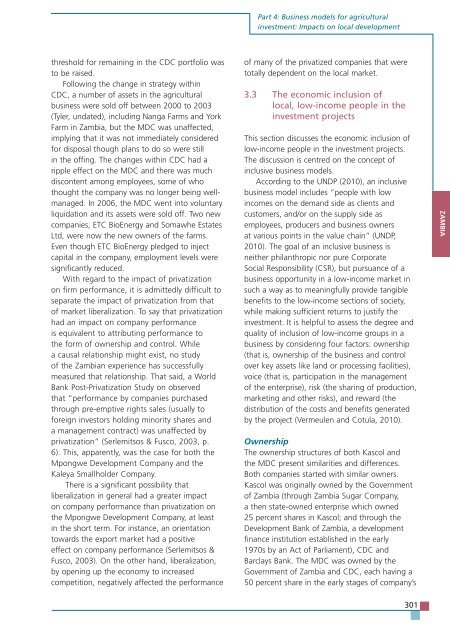TRENDS AND IMPACTS OF FOREIGN INVESTMENT IN DEVELOPING COUNTRY AGRICULTURE
TRENDS AND IMPACTS OF FOREIGN INVESTMENT IN DEVELOPING COUNTRY AGRICULTURE
TRENDS AND IMPACTS OF FOREIGN INVESTMENT IN DEVELOPING COUNTRY AGRICULTURE
Create successful ePaper yourself
Turn your PDF publications into a flip-book with our unique Google optimized e-Paper software.
threshold for remaining in the CDC portfolio was<br />
to be raised.<br />
Following the change in strategy within<br />
CDC, a number of assets in the agricultural<br />
business were sold off between 2000 to 2003<br />
(Tyler, undated), including Nanga Farms and York<br />
Farm in Zambia, but the MDC was unaffected,<br />
implying that it was not immediately considered<br />
for disposal though plans to do so were still<br />
in the offing. The changes within CDC had a<br />
ripple effect on the MDC and there was much<br />
discontent among employees, some of who<br />
thought the company was no longer being wellmanaged.<br />
In 2006, the MDC went into voluntary<br />
liquidation and its assets were sold off. Two new<br />
companies, ETC BioEnergy and Somawhe Estates<br />
Ltd, were now the new owners of the farms.<br />
Even though ETC BioEnergy pledged to inject<br />
capital in the company, employment levels were<br />
significantly reduced.<br />
With regard to the impact of privatization<br />
on firm performance, it is admittedly difficult to<br />
separate the impact of privatization from that<br />
of market liberalization. To say that privatization<br />
had an impact on company performance<br />
is equivalent to attributing performance to<br />
the form of ownership and control. While<br />
a causal relationship might exist, no study<br />
of the Zambian experience has successfully<br />
measured that relationship. That said, a World<br />
Bank Post-Privatization Study on observed<br />
that “performance by companies purchased<br />
through pre-emptive rights sales (usually to<br />
foreign investors holding minority shares and<br />
a management contract) was unaffected by<br />
privatization” (Serlemitsos & Fusco, 2003, p.<br />
6). This, apparently, was the case for both the<br />
Mpongwe Development Company and the<br />
Kaleya Smallholder Company.<br />
There is a significant possibility that<br />
liberalization in general had a greater impact<br />
on company performance than privatization on<br />
the Mpongwe Development Company, at least<br />
in the short term. For instance, an orientation<br />
towards the export market had a positive<br />
effect on company performance (Serlemitsos &<br />
Fusco, 2003). On the other hand, liberalization,<br />
by opening up the economy to increased<br />
competition, negatively affected the performance<br />
Part 4: Business models for agricultural<br />
investment: Impacts on local development<br />
of many of the privatized companies that were<br />
totally dependent on the local market.<br />
3.3 The economic inclusion of<br />
local, low-income people in the<br />
investment projects<br />
This section discusses the economic inclusion of<br />
low-income people in the investment projects.<br />
The discussion is centred on the concept of<br />
inclusive business models.<br />
According to the UNDP (2010), an inclusive<br />
business model includes “people with low<br />
incomes on the demand side as clients and<br />
customers, and/or on the supply side as<br />
employees, producers and business owners<br />
at various points in the value chain” (UNDP,<br />
2010). The goal of an inclusive business is<br />
neither philanthropic nor pure Corporate<br />
Social Responsibility (CSR), but pursuance of a<br />
business opportunity in a low-income market in<br />
such a way as to meaningfully provide tangible<br />
benefits to the low-income sections of society,<br />
while making sufficient returns to justify the<br />
investment. It is helpful to assess the degree and<br />
quality of inclusion of low-income groups in a<br />
business by considering four factors: ownership<br />
(that is, ownership of the business and control<br />
over key assets like land or processing facilities),<br />
voice (that is, participation in the management<br />
of the enterprise), risk (the sharing of production,<br />
marketing and other risks), and reward (the<br />
distribution of the costs and benefits generated<br />
by the project (Vermeulen and Cotula, 2010).<br />
Ownership<br />
The ownership structures of both Kascol and<br />
the MDC present similarities and differences.<br />
Both companies started with similar owners.<br />
Kascol was originally owned by the Government<br />
of Zambia (through Zambia Sugar Company,<br />
a then state-owned enterprise which owned<br />
25 percent shares in Kascol; and through the<br />
Development Bank of Zambia, a development<br />
finance institution established in the early<br />
1970s by an Act of Parliament), CDC and<br />
Barclays Bank. The MDC was owned by the<br />
Government of Zambia and CDC, each having a<br />
50 percent share in the early stages of company’s<br />
301<br />
ZAMBIA


